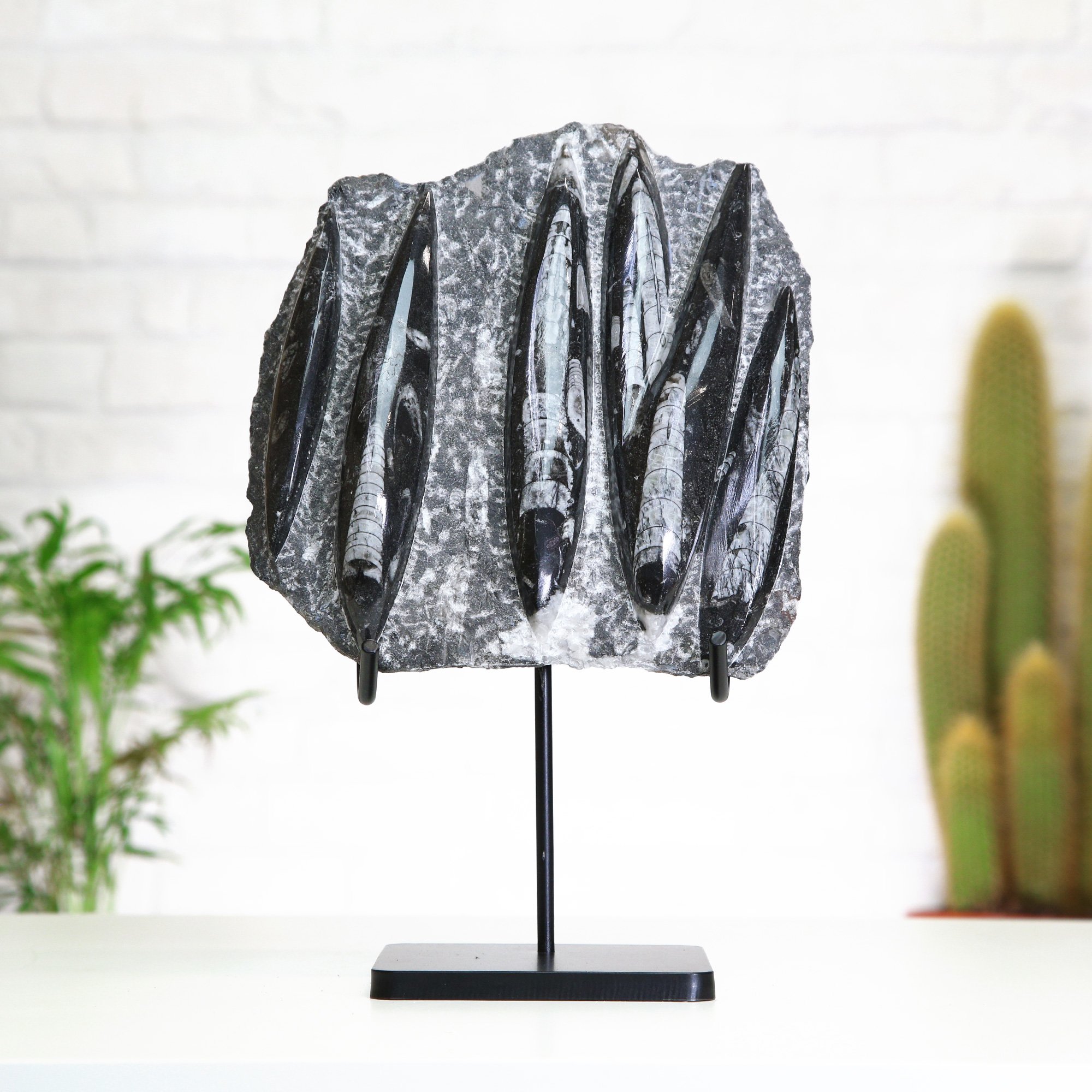 Image 1 of 4
Image 1 of 4

 Image 2 of 4
Image 2 of 4

 Image 3 of 4
Image 3 of 4

 Image 4 of 4
Image 4 of 4





Madagascan Ammonite and Watercolour Illustration
This Madagascan Ammonite Fossil has been displayed and elegantly mounted in a museum quality deep box frame, by our expert in-house team and is accompanied by a detailed sketch of this species.
Ammonites are a group of extinct marine molluscs, closely related to modern day octopuses and squids. They were one of the most successful and diverse groups of animals on earth, with more than 10,000 species identified from nearly everywhere on the planet where oceans once existed. The largest species of ammonite discovered is a partial fossil of Parapuzosia seppenradensis, which is estimated at being 8 - 11 ft in diameter! Because ammonites were so common and evolved so rapidly they are a useful tool for both palaeontologists and geologists to help determine the age of the rocks they were fossilised in.
Frame: Satin finished acrylic
Mount: 300 GSM acid free card stock with a 2 mm bevelled edge matboard border
Display: Self standing frame or wall hanging bracket
Dimensions: 31 x 26 x 6 cm
Informed by detailed knowledge and understanding of dinosaur anatomy, this watercolour design has been created by a published scientific illustrator and specially commissioned for our paleo collection.
The picture shown is an example of the quality that you can expect to receive. Please be aware that, as these are natural products, they are subject to some variation.
We work closely with reputable suppliers all over the world to source high quality, genuine specimens. Each fossil comes with a certificate of authenticity documenting the provenance of each specimen, including the age and location where it was discovered.
What you will receive with your order
Every frame comes with a loyalty bug sticker, collect 6 to fill your loyalty card & receive a free Bug Club frame!
This Madagascan Ammonite Fossil has been displayed and elegantly mounted in a museum quality deep box frame, by our expert in-house team and is accompanied by a detailed sketch of this species.
Ammonites are a group of extinct marine molluscs, closely related to modern day octopuses and squids. They were one of the most successful and diverse groups of animals on earth, with more than 10,000 species identified from nearly everywhere on the planet where oceans once existed. The largest species of ammonite discovered is a partial fossil of Parapuzosia seppenradensis, which is estimated at being 8 - 11 ft in diameter! Because ammonites were so common and evolved so rapidly they are a useful tool for both palaeontologists and geologists to help determine the age of the rocks they were fossilised in.
Frame: Satin finished acrylic
Mount: 300 GSM acid free card stock with a 2 mm bevelled edge matboard border
Display: Self standing frame or wall hanging bracket
Dimensions: 31 x 26 x 6 cm
Informed by detailed knowledge and understanding of dinosaur anatomy, this watercolour design has been created by a published scientific illustrator and specially commissioned for our paleo collection.
The picture shown is an example of the quality that you can expect to receive. Please be aware that, as these are natural products, they are subject to some variation.
We work closely with reputable suppliers all over the world to source high quality, genuine specimens. Each fossil comes with a certificate of authenticity documenting the provenance of each specimen, including the age and location where it was discovered.
What you will receive with your order
Every frame comes with a loyalty bug sticker, collect 6 to fill your loyalty card & receive a free Bug Club frame!
This Madagascan Ammonite Fossil has been displayed and elegantly mounted in a museum quality deep box frame, by our expert in-house team and is accompanied by a detailed sketch of this species.
Ammonites are a group of extinct marine molluscs, closely related to modern day octopuses and squids. They were one of the most successful and diverse groups of animals on earth, with more than 10,000 species identified from nearly everywhere on the planet where oceans once existed. The largest species of ammonite discovered is a partial fossil of Parapuzosia seppenradensis, which is estimated at being 8 - 11 ft in diameter! Because ammonites were so common and evolved so rapidly they are a useful tool for both palaeontologists and geologists to help determine the age of the rocks they were fossilised in.
Frame: Satin finished acrylic
Mount: 300 GSM acid free card stock with a 2 mm bevelled edge matboard border
Display: Self standing frame or wall hanging bracket
Dimensions: 31 x 26 x 6 cm
Informed by detailed knowledge and understanding of dinosaur anatomy, this watercolour design has been created by a published scientific illustrator and specially commissioned for our paleo collection.
The picture shown is an example of the quality that you can expect to receive. Please be aware that, as these are natural products, they are subject to some variation.
We work closely with reputable suppliers all over the world to source high quality, genuine specimens. Each fossil comes with a certificate of authenticity documenting the provenance of each specimen, including the age and location where it was discovered.
What you will receive with your order
Every frame comes with a loyalty bug sticker, collect 6 to fill your loyalty card & receive a free Bug Club frame!




